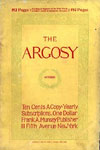Contexts: Graph
Pulp Market Share, 1922
The table below includes market-share data and overall percentages for the 35 pulp magazine titles published in 1922. Represented here are seven of the major pulp magazine genres of the period: Adventure, Detective, General, Humor, Romance, Saucy, and Western. The information included in this table was compiled by Jess Nevins―an author, pop culture historian, and reference librarian at Lone Star College, Tomball; his conclusions, based on this information, are also included below. The PMP would like to thank Mr. Nevins for the opportunity to reprint "Pulp Market Share, 1922."
|
Title Data: 35 Pulps Published
|
||
|
Featured Genre
|
# of Titles
|
Market Share
|
|
Adventure
|
4
|
11.4%
|
|
Detective
|
3
|
8.6%
|
|
General
|
12
|
34.3%
|
|
Humor
|
1
|
2.9%
|
|
Romance
|
4
|
11.4%
|
|
Saucy
|
10
|
28.6%
|
|
Western
|
2
|
5.7%
|
|
Issue Data: 597 Total Issues
|
||
|
Featured Genre
|
# of Issues
|
Market Share
|
| Adventure | 79 | 13.2% |
| Detective | 79 | 13.2% |
| General | 212 | 35.5% |
| Humor | 12 | 2% |
| Romance | 72 | 12.1% |
| Saucy | 114 | 19.1% |
| Western | 53 | 8.9% |
|
Combined Data; Arranged by Size
|
||
|
Featured Genre
|
Market Share, Titles
|
Market Share, Issues
|
| General | 34.3% | 35.5% |
| Saucy | 28.6% | 19.1% |
| Adventure | 11.4% | 13.2% |
| Romance | 11.4% | 12.1% |
| Detective | 8.6% | 13.2% |
| Western | 5.7% | 8.9% |
| Humor | 2.9% | 2% |
|
Conclusions: The year 1922 is an important year for pulp magazines. The total number of pulp titles published annually slips this year from 37 (in 1921) to 35 (1922). Though this is not unusual—there were declines from 1915-16 and 1917-18 as well—1922 is the last year in which there will be a decline in the total number of titles published annually until 1932, when the Depression finally hits the pulp industry. More or less beginning in 1922, the pulp industry really takes off: the number of pulps published doubles within the next three years (82 in 1925), then doubles again four years later (168 in 1929). The pulps began in 1896; by 1919, their circulations had supplanted those of dime novels; but 1922 is the year when pulps really started to become The Pulps. Not that you can tell this from the raw numbers here. The number of General titles dropped from 18 to 12 in 1922, but there were only 12 General pulps in 1920—and the 18 is a fluke rather than an indicator of anything. There was one more Adventure pulp in 1922 than in 1921 (Sea Stories), one more Romance (I Confess), one more Western (The Round-Up); and of those three the Western, Round-Up, was cancelled after just one issue. Based just on the number of titles published, the industry seems to be holding steady and little more. The real clue here is the rate of publication. The eighteen-month recession is over, sales are increasing, and the market for pulps is promising. In 1922, I Confess debuts as a biweekly pulp in January, Saucy Stories goes biweekly in July, Love Story Magazine goes biweekly in late August, and Ace-High Magazine and Live Stories go biweekly in October. None of these pulps are minor titles; I Confess is probably the least-known of the group, even though it lasted for ten years and 209 issues and was a dependably solid Romance pulp. The publishers of these magazines wouldn't have increased the rate of publication without a lot of confidence in the market—a confidence which was borne out by events. January 1922 marks the debut of Street & Smith's Sea Stories Magazine; by September it too goes biweekly. A lesser-known (today) Adventure pulp of surprisingly good quality, Sea Stories, despite its seeming niche appeal, would last for 10 years and 138 issues and become one of the mainstays of the Adventure genre. The year 1922 also marks the five-year mark since pulp magazine circulations tied those of dime novels. General's market share is slowly declining, and will continue to do so. Surprisingly, so is Detective's, down 5% (18.6% to 13.2%) since 1918. Romance is up. Saucy remains strong. And Western, one of the eventual Top Three pulp genres? It's been three years since Western Story Magazine debuted (1919); in 1922 WSM is publishing weekly. And since WSM's debut only one other Western pulp, The Round-Up, has appeared on the market, and it only lasted for one issue in 1922. It may be that publishers thought Street & Smith's marketing and sales power alone were responsible for Western Story Magazine's success. Or possibly that publishers thought fans of the Western were already getting their fix from Western Story and the dime novels Buffalo Bill Stories and Wild West Weekly, and wouldn't be interested in another Western-themed fiction magazine. Whatever the reason, Westerns are much slower than the other major genres in catching on in the pulps. Jess Nevins, Lone Star College-Tomball This essay has been reprinted—by permission of the author—from an earlier version which first appeared @ Not by the Direct Method (November 12, 2010), http://jessnevins.tumblr.com/post/2084331724/pulp-market-share-1922. |
||


